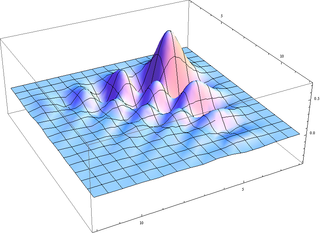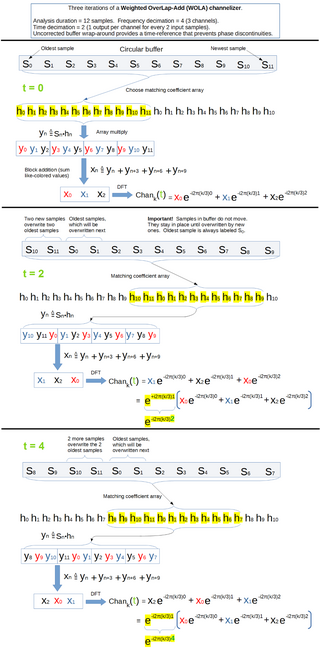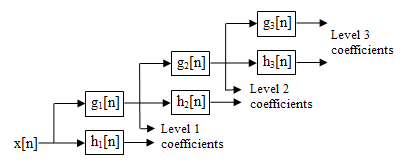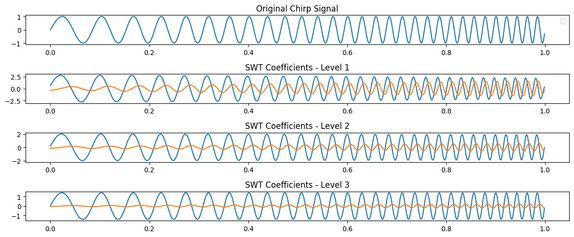Digital signal processing (DSP) is the use of digital processing, such as by computers or more specialized digital signal processors, to perform a wide variety of signal processing operations. The digital signals processed in this manner are a sequence of numbers that represent samples of a continuous variable in a domain such as time, space, or frequency. In digital electronics, a digital signal is represented as a pulse train, which is typically generated by the switching of a transistor.

A wavelet is a wave-like oscillation with an amplitude that begins at zero, increases or decreases, and then returns to zero one or more times. Wavelets are termed a "brief oscillation". A taxonomy of wavelets has been established, based on the number and direction of its pulses. Wavelets are imbued with specific properties that make them useful for signal processing.
In digital signal processing, a quadrature mirror filter is a filter whose magnitude response is the mirror image around of that of another filter. Together these filters, first introduced by Croisier et al., are known as the quadrature mirror filter pair.

The Daubechies wavelets, based on the work of Ingrid Daubechies, are a family of orthogonal wavelets defining a discrete wavelet transform and characterized by a maximal number of vanishing moments for some given support. With each wavelet type of this class, there is a scaling function which generates an orthogonal multiresolution analysis.

In numerical analysis and functional analysis, a discrete wavelet transform (DWT) is any wavelet transform for which the wavelets are discretely sampled. As with other wavelet transforms, a key advantage it has over Fourier transforms is temporal resolution: it captures both frequency and location information.

In signal processing, a filter bank is an array of bandpass filters that separates the input signal into multiple components, each one carrying a sub-band of the original signal. One application of a filter bank is a graphic equalizer, which can attenuate the components differently and recombine them into a modified version of the original signal. The process of decomposition performed by the filter bank is called analysis ; the output of analysis is referred to as a subband signal with as many subbands as there are filters in the filter bank. The reconstruction process is called synthesis, meaning reconstitution of a complete signal resulting from the filtering process.
The fast wavelet transform is a mathematical algorithm designed to turn a waveform or signal in the time domain into a sequence of coefficients based on an orthogonal basis of small finite waves, or wavelets. The transform can be easily extended to multidimensional signals, such as images, where the time domain is replaced with the space domain. This algorithm was introduced in 1989 by Stéphane Mallat.
A multiresolution analysis (MRA) or multiscale approximation (MSA) is the design method of most of the practically relevant discrete wavelet transforms (DWT) and the justification for the algorithm of the fast wavelet transform (FWT). It was introduced in this context in 1988/89 by Stephane Mallat and Yves Meyer and has predecessors in the microlocal analysis in the theory of differential equations and the pyramid methods of image processing as introduced in 1981/83 by Peter J. Burt, Edward H. Adelson and James L. Crowley.
In signal processing, the second-generation wavelet transform (SGWT) is a wavelet transform where the filters are not designed explicitly, but the transform consists of the application of the Lifting scheme. Actually, the sequence of lifting steps could be converted to a regular discrete wavelet transform, but this is unnecessary because both design and application is made via the lifting scheme. This means that they are not designed in the frequency domain, as they are usually in the classical transforms such as the DWT and CWT). The idea of moving away from the Fourier domain was introduced independently by David Donoho and Harten in the early 1990s.
Originally known as optimal subband tree structuring (SB-TS), also called wavelet packet decomposition, is a wavelet transform where the discrete-time (sampled) signal is passed through more filters than the discrete wavelet transform (DWT).
The complex wavelet transform (CWT) is a complex-valued extension to the standard discrete wavelet transform (DWT). It is a two-dimensional wavelet transform which provides multiresolution, sparse representation, and useful characterization of the structure of an image. Further, it purveys a high degree of shift-invariance in its magnitude, which was investigated in. However, a drawback to this transform is that it exhibits redundancy compared to a separable (DWT).

In mathematics, a wavelet series is a representation of a square-integrable function by a certain orthonormal series generated by a wavelet. This article provides a formal, mathematical definition of an orthonormal wavelet and of the integral wavelet transform.

The lifting scheme is a technique for both designing wavelets and performing the discrete wavelet transform (DWT). In an implementation, it is often worthwhile to merge these steps and design the wavelet filters while performing the wavelet transform. This is then called the second-generation wavelet transform. The technique was introduced by Wim Sweldens.
In mathematics, Fourier–Bessel series is a particular kind of generalized Fourier series based on Bessel functions.
Ali Naci Akansu is a Turkish-American professor of electrical & computer engineering and scientist in applied mathematics.
Contourlets form a multiresolution directional tight frame designed to efficiently approximate images made of smooth regions separated by smooth boundaries. The contourlet transform has a fast implementation based on a Laplacian pyramid decomposition followed by directional filterbanks applied on each bandpass subband.
In signal processing it is useful to simultaneously analyze the space and frequency characteristics of a signal. While the Fourier transform gives the frequency information of the signal, it is not localized. This means that we cannot determine which part of a signal produced a particular frequency. It is possible to use a short time Fourier transform for this purpose, however the short time Fourier transform limits the basis functions to be sinusoidal. To provide a more flexible space-frequency signal decomposition several filters have been proposed. The Log-Gabor filter is one such filter that is an improvement upon the original Gabor filter. The advantage of this filter over the many alternatives is that it better fits the statistics of natural images compared with Gabor filters and other wavelet filters.
This article provides a short survey of the concepts, principles and applications of Multirate Filter Banks and Multidimensional Directional Filter Banks.
Wavelets are often used to analyse piece-wise smooth signals. Wavelet coefficients can efficiently represent a signal which has led to data compression algorithms using wavelets. Wavelet analysis is extended for multidimensional signal processing as well. This article introduces a few methods for wavelet synthesis and analysis for multidimensional signals. There also occur challenges such as directivity in multidimensional case.

























